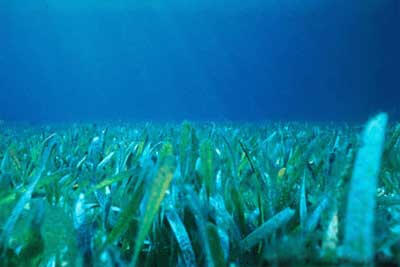Around the world, seaweed is disappearing at a rate that threatens the survival of many species, seaweed provides food and habitat for a wide variety of fish, reptiles and mammals, as well as badgers, turtles, seahorses and many others

Some time ago I attended an operation dachshund dead. Even before the beginning of the analysis, it was possible to see how and why the belief in the existence of "mermaids" developed among seafarers in ancient times,
The purpose of the analysis was to learn about the anatomy of the aquatic mammal and try to determine the cause of its death. The cause of death was immediately discovered when we opened the dachshund's stomach. A large block of plastic bags just blocked the passage to the small intestine.
I remembered the event because of a new study that was published these days on the food of the dachshunds, Prof. Frederick Short, who serves as the director of the Seagrass Research Institute Research Professor and Director of SeagrassNet publishes in the monthly "Biological conservation"
Biological the results of the initial study according to which 14% of the seaweed species (and the fresh water) are in danger of extinction. Other species that are considered common are also in decline. Around the world, seaweed is disappearing at a rate that threatens the survival of many species, seaweed provides food and habitat for a wide variety of fish, reptiles and mammals, as well as for badgers (one of which was mentioned in the opening), turtles, seahorses and many others.
Seaweed belongs to those with flowers, but unlike terrestrial plants, seagrass grows in the depths of the sea (or in freshwater bodies), millions of years ago land plants developed and "descended" into the water. The decline of flowering plants into the water created important and diverse marine (aquatic) habitats, which are parallel to terrestrial meadows or marshes, the seagrass surfaces constitute areas of reproduction and development (birth rooms, gardens , gardens and nurseries) for fish and shellfish and these are the beginning of many species, the seagrass protects and contributes to the health of coral reefs, shells and mangrove areas.
Of the 72 seagrass species tested, 26 species are in decline and 13 species are increasing. The rest are stable or their condition is unknown, the damage to the seagrass population was known but the extent of the damage was not clear. For example, many species are disappearing from most developed beaches mainly because of pollution.
Seaweed will be directly damaged due to the use of trawl nets, in the countries of the developing world, seagrass areas are damaged due to the deposition of sediments that multiply as a result of damage to watersheds and drainage areas of rivers and streams, the streams sweep away nutrients (nutrients/ fertilizers) from agricultural areas and sewage and these cause damage to the marine environment. Based on the knowledge of the damage, teams gathered and gathered everything known about different species to assess the condition of each species and try to check what can be done. As a result of the conference, the researcher (Short) said that: "He was surprised to discover the level of risk to many species and the fact that the biodiversity of seaweed is under threat."
It was fitting that, of the species tested, many would be classified as endangered according to the indices of The International Organization for the Conservation of Nature(IUCN) of which 10 species are in immediate danger of extinction. Seagrass species on the rocky shores of China, the coasts of South Korea and Japan have disappeared due to the development of aquaculture. Seaweed species for the coasts of Chile no longer exist, and thus many species disappear even before they have been identified and classified.
Seaweed is a direct food for many important species, a habitat for other species including fish species that are important to the economy, seagrass is the basis of a long and vital marine (aquatic) food chain, therefore despite Being hidden in the depths, its preservation is of utmost importance.

One response
A distinction must be made between seaweed, plants that developed on land
As having flowers and "descended" they adapted to an aquatic/marine environment,
I have most of the parts of the plant that we know on land: leaves, stems, etc.
(The list refers to them)
and algae (alga) which include a wide group of unicellular plants
some of which cluster into colonies that give the illusion of one body.